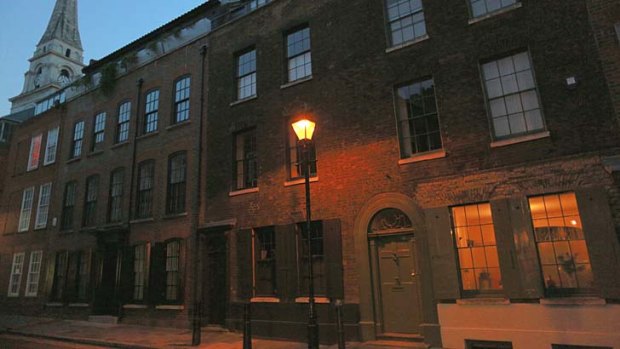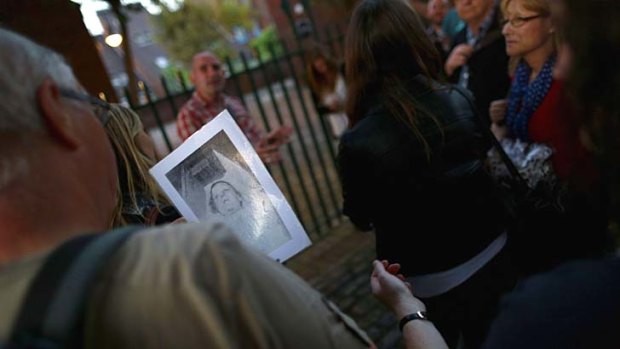By Jolyon Attwooll

A street near Spitafileds market where Jack the Ripper killed most of his victims in London.Credit: AFP
As speculation mounts about Jack the Ripper's identity, we take a look at sites associated with the macabre Whitechapel murders of 1888.
The identity of Jack the Ripper, the killer who terrorised the streets of Whitechapel with a macabre series of murders of women in 19th-century London, may no longer be a mystery.
Since the spate of at least five killings in the area, there has been speculation about who the murderer really was, with varying theories blaming Queen Victoria's surgeon to members of the aristocracy.
However, Russell Edwards - described as an "armchair detective" - has a more prosaic theory. In a new book he claims Aaron Kosminski, a 23-year-old Polish immigrant who died in an asylum, was "definitely, categorically and absolutely" the man behind the murders.
Mr Edwards says a blood-stained shawl he bought in 2007 at an auction in Bury St Edmunds, Suffolk, held vital DNA evidence that allowed him to identify the murderer.
While not universally accepted, his analysis is being treated as more credible than previous attempts to identify the killer.

An old black and white photograph of a victim is passed around a group during a Jack the Ripper guided walk in London.Credit: AFP
Whatever the truth, many sites associated with London's most notorious series of murders can still be seen in the East End – and Jack the Ripper-themed walks remain popular walks. Here are some of the locations associated with the killer.
Ten Bells Pub
The Ten Bells pub lies at the corner of Commercial Street and Fournier Street in Spitalfields, and has associations with two victims of Jack the Ripper, Annie Chapman and Mary Kelly. Annie Chapman is even said to have had her last drink alive here. It is now a fashionable watering hole.
Site of Mary Ann Nichols murder
Mary Ann Nichols is often thought to be Jack the Ripper's first victim (although disputed by some). She was found in the early morning of August 31, 1888, with her throat slit and mutilated in the way that would become the gruesome trademark of the so-called Whitechapel Murders. She was found in Buck's Row, a street in the area. Apparently, residents became so ashamed of the Jack the Ripper associations that it was renamed Durward Street.
Site of Annie Chapman's murder
Annie Chapman's body was discovered in Hanbury Street in the early morning of September 8, 1888 after she fought with a fellow resident of Crossingham's lodging house in Dorset Street (the so called worst street in London).
Site of Elizabeth Stride's murder
Elizabeth Stride's body was discovered on Sunday September 30, 1888 in Dutfield's Yard. The yard where the murder took place has now been replaced by a school building. She was killed but not mutilated, leading to speculation that the killer was interrupted.
Site of Catherine Eddowes's murder
Early on September 30 1888 - the same night as Elizabeth Stride's death - Catherine Eddowes's mutilated body was found in the south-west corner of Mitre Square by a policeman. It was the only one of the murders to take place within the City. It was her shawl that Mr Edwards claims to have.
Site of Mary Jane Kelly's murder
Thought to have been Jack the Ripper's final victim, she was found on the morning of November 9, 1888 by her landlord's assistant.
Former Frying Pan pub, Brick Lane
13 Brick Lane is the site of the former Frying Pan pub, where one of the victims, Mary Ann Nichols, left shortly before her death. It is now a curry house and hotel and stands on the corner of Thrawl Street where she lived at the time of her murder.
St Leonard's Church Shoreditch
Mary Kelly's body was taken to a mortuary associated with St Leonard's Church in Shoreditch, and then transferred to St Patrick's Cemetery, Leyton, where she was buried. There is now a memorial stone at the cemetery and people still lay flowers in her memory.
You may also be interested in: George Yard Buildings (now demolished)
Here, the body of Martha Turner was discovered on August 8, 1888. Some experts believe she was the first victim, while others believe her injuries were not consistent with those inflicted on the bodies of other.
The Crime Museum, New Scotland Yard
Not open to the general public, this macabre museum is better known as The Black Museum. Housing an extensive number of weapons which have been used to commit murders or serious assaults in London, it has a collection that includes items used by Jack the Ripper and Charlie Peace.
Bishopsgate Police Station
Bishopgate Police Station played a key role in one of the grisly killings, having kept in Catherine Eddowes for drunken behaviour, then releasing her late at night on the evening she was murdered. The current police station, however, is not the original, which was replaced in the mid-20th Century.
The Telegraph, London
Sign up for the Traveller Deals newsletter
Get exclusive travel deals delivered straight to your inbox. Sign up now.